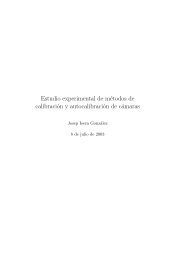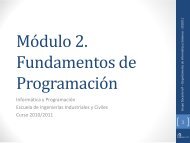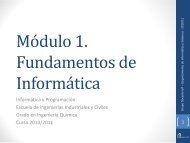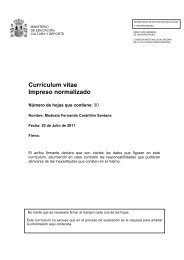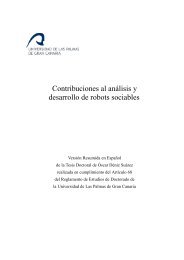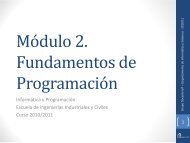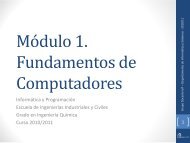PhD Document - Universidad de Las Palmas de Gran Canaria
PhD Document - Universidad de Las Palmas de Gran Canaria
PhD Document - Universidad de Las Palmas de Gran Canaria
Create successful ePaper yourself
Turn your PDF publications into a flip-book with our unique Google optimized e-Paper software.
CHAPTER 1. INTRODUCTION<br />
very similar to that of Kismet, albeit this was not achieved intentionally). It is an animal-like<br />
robotic head with facial expressions. Developed in the context of the Social Machines Project<br />
at MIT, it can engage people in natural and expressive face-to-face interaction. Kismet<br />
was conceived as a baby robot, its abilities were <strong>de</strong>signed to produce caregiver-infant ex-<br />
changes that would eventually make it more <strong>de</strong>xterous. An overview of Kismet is available<br />
at [MIT AI lab, Humanoid Robotics Group, 2003].<br />
Kismet is equipped with visual, auditory and proprioceptive inputs. The vision sys-<br />
tem inclu<strong>de</strong>s four colour CCD cameras. Two of them have a larger field of view, and the<br />
other two are foveal cameras that allow higher-resolution processing. Kismet’s gaze is con-<br />
trolled by three <strong>de</strong>grees of freedom in the eyes and another three in the neck. An attentional<br />
system based on basic visual features like skin tone, colour and motion allows it to direct its<br />
attention to relevant stimuli and gaze toward them. The auditory system processes signals<br />
gathered by a wireless microphone worn by the caregiver. The auditory system can recog-<br />
nize the affective intent of the speaker, i.e. it can recognize praise, prohibition, attention, and<br />
comfort.<br />
Kismet’s face has 15 DOF that allows it to display facial expressions like fear, ac-<br />
cepting, tired, unhappy, disgust, surprise, anger, stern and content. The vocalization system<br />
is based on a DECtalk v4.5 speech synthesizer in which parameters are adjusted to convey<br />
personality (Kismet babbles like a young child) and emotional state.<br />
Another MIT robot, Cog [Adams et al., 2000, Brooks et al., 1999, Scassellati, 2000],<br />
has a trunk, head and arms, for a total of 22 <strong>de</strong>grees of freedom. The head has 4 DOF in<br />
the neck and 3 DOF in the eyes. Its capabilities inclu<strong>de</strong> human-like eye movements, head<br />
and neck orientation (in the direction of a target), face and eye <strong>de</strong>tection, imitation of head<br />
nods, basic visual feature <strong>de</strong>tectors (colour, motion and skin tone), an attentional system<br />
that combines them, sound localization, reflex arm withdrawal, shared attention (see below),<br />
reaching to visual targets and oscillatory arm movements. Recently, the work of Arsenio<br />
[Arsenio, 2004] has endowed the robot with significant high-level capabilities such as object,<br />
face and scene recognition, acoustic segmentation and recognition, activity recognition, etc.<br />
Both Kismet and Cog were <strong>de</strong>veloped with the aim of exploiting scaffolding. Scaf-<br />
folding is a teaching strategy introduced by Constructivist psychologist Vygotsky’s sociocul-<br />
tural theory. Parents modulate and facilitate learning by creating an appropriate environment<br />
for the infant. Aspects like the use of simple phrases and achievable goals can facilitate<br />
learner’s <strong>de</strong>velopment. In the case of a robot, an instructor would gui<strong>de</strong> interactions so as to<br />
foster novel abilities. The instructor may for example mark the critical aspects of the task or<br />
concept to learn, reduce the <strong>de</strong>grees of freedom, show the robot the effects of its actions with<br />
6



